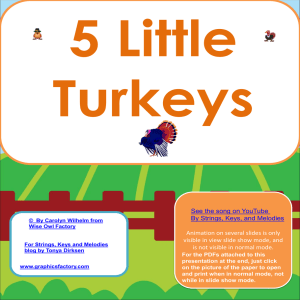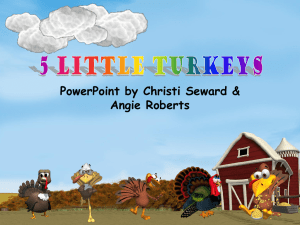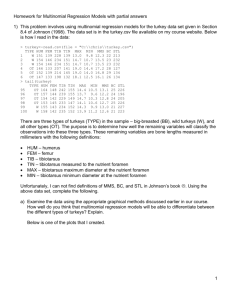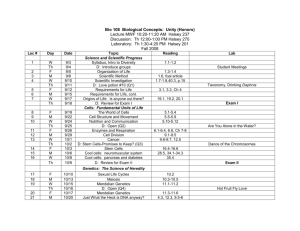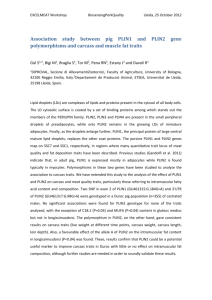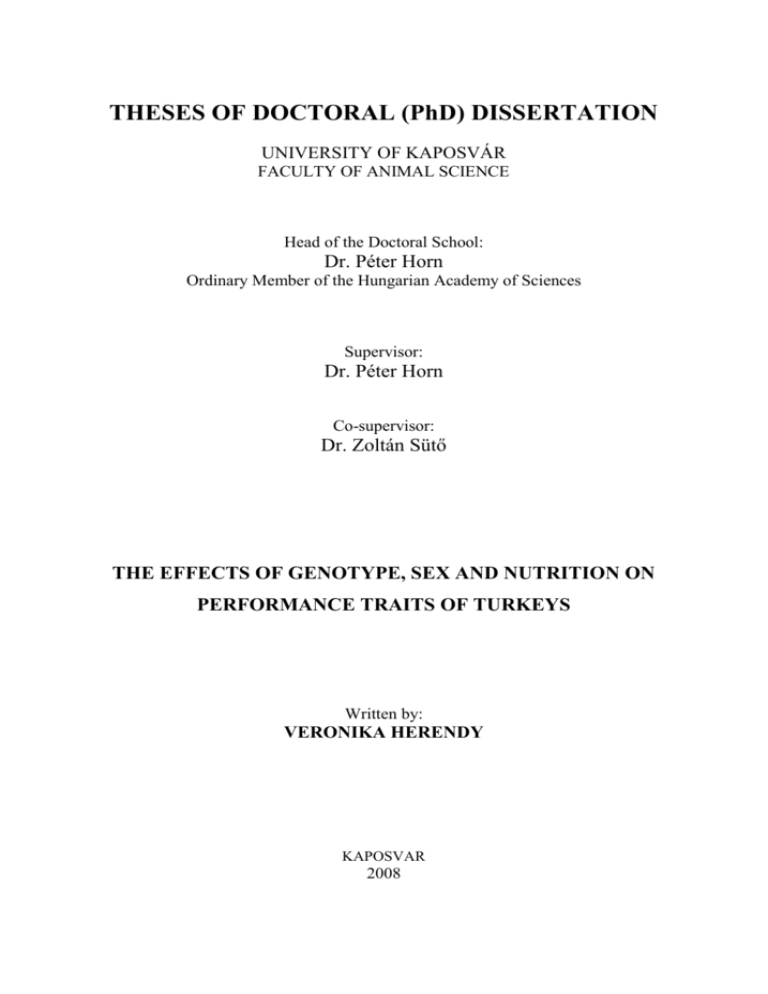
THESES OF DOCTORAL (PhD) DISSERTATION
UNIVERSITY OF KAPOSVÁR
FACULTY OF ANIMAL SCIENCE
Head of the Doctoral School:
Dr. Péter Horn
Ordinary Member of the Hungarian Academy of Sciences
Supervisor:
Dr. Péter Horn
Co-supervisor:
Dr. Zoltán Sütő
THE EFFECTS OF GENOTYPE, SEX AND NUTRITION ON
PERFORMANCE TRAITS OF TURKEYS
Written by:
VERONIKA HERENDY
KAPOSVAR
2008
I. INTRODUCTION
Turkey production and turkey meat consumption increased dramatically in the past 30-40 years
in developed countries, among others in Hungary as well.
Main contributing factors to this development were genetic selection, innovations in feeding
and environmental management (lighting program, ventilation – climatization etc.), artificial
insemination, veterinary practices applied and efficiencies of vertical integration.
Broadly formulated the aim of the first experiment was to determine the effects of genetic
improvement and feeding management on performance traits of turkeys related to meat
production, taking sex as a third factor into consideration, comparing bronze type turkeys of
the type of 1960s and BUT Big 6 turkeys of the year 1999.
The aim of the experiment was to answer the following questions:
1.
How did selection alter the main rearing and slaughter traits of turkeys?
2.
How much impact is attributable to improvement in nutrition on the same traits?
3.
Considering the two previously listed factors are there sex determined specific
differences in reactions and if so to what extent?
4.
What is the nature of the genetic, nutritional and sex as main effects and their
interaction variances and to what extent are they age dependent.
In the second experiment reported large type turkeys of the year 1979 and 2003 were compared
to asses trends in genetic improvement also considering changes in performance between 1966
and 1979.
II. MATERIALS AND METHODS
1.1.
The first experiment
1.1.1. Genetic stocks
In the experiment two distinctly different turkey populations were used.
The bronze turkey strain represented the typical turkey type used extensively in
Hungary in the 1960s to produce turkey meat. This stock was maintained since 1962 as
indigeneous breed and bred without systematic selection using methods relevant for
2
genetic stock preservation (or control strains). For this trial the stock was provided by
the University of Debrecen, Agricultural Center.
The other turkey population was a large type commercial turkey, BUT Big 6 bred and
selected by British United Turkeys since over 30 years, and is one of the leading
turkey hybrid commercial stocks in the world. This population represented the typical
type of turkey in 1999.
Both stocks were provided by the breeders as hatching eggs.
In the trial till 42 days of age male turkeys were reared at 5 bird/m2 density level, from
each genotype 50 birds/pen got the 1967 type feed, the other pens the 1999 type feed.
Females were reared at 6 bird/m2 density, 60 bird/pen was applied, 2 pens/genotype
and feed treatment combination were used. For males a total of 2 x 2 x 50 = 200 birds,
from females 2 x 2 x 2 x 60 = 480 birds started the trial. After 6 weeks of age poults
were randomly allotted to 16, 10 m2 pens each. From each treatment combination (2
genotypes x 2 feeding levels x 2 sexes = 8 treatments combinations) two replicate pens
were used. In the female pens 4 birds/m2 density, in the male pens 2 birds/m2 density
level was applied. The 8 female pens housed a total as 40 x 8 = 320 birds, the 8 male
pens 20 x 8 = 160 birds.
1.1.2. Nutrition
All turkeys on test have been reared from one day of age till 20 weeks of age on two
distinctly different diets. One diet was formulated following the description of
Baintner (1967) representing the typical feed composition used widely in the mid
1960s in Hungary. This diet was fed in mash form as recommended. The modern diet
was designed by Agrokomplex Central Soya, representing the typical turkey rearing
diet used in 1999. The diet was fed in crumble and granulated form. Both diets were
fed ad libitum during the entire rearing period.
3
1.1.3. Management
The eggs were hatched in the experimental hatchery at the Animal Science Faculty
research Farm. After hatch all poults were sexed. Rearing was on litter, sex separate.
The test started on 14. 06. 2000, terminated on 01. 11. 2000.
Lighting and climatization technology was identical to the good commercial practice,
matching also BUT recommendations for windowless, closed houses. Vaccination
program was identical to BUT and Hungarian official regulations.
1.1.4. Traits measured
Rearing traits
Live weight was determined: at 4, 6, 10, 14, 16 and 20 weeks of age (10 g precision).
All individuals were measured on test. Feed conversion: feed consumed was measured
on pen basis. Corrections were performed for those birds selected for dissection For
losses during rearing no correction was practiced, this was regarded as part of the
treatment effect.
Livability
all losses during rearing were recorded on pen basis.
Carcass traits
Carcass traits were measured at 6, 16 and 20 weeks of age.
From each treatment combination (genotype, nutrition, sex) 5 animals were selected at
6 and 16 weeks of age, representing the mean live weight of the respective treatment
combination. This method minimizes the experimental error compared to other
sampling procedures (Moran et al, 1991). At 20 weeks of age a total of 10 birds were
slaughtered from each treatment combination.
A standard dissection procedure was used, described by Jensen (1983).
The following traits were measured characterizing the turkey body composition:
1. Pre slaughter weight (g)
2. Carcass weight (g) = grillfertig weight (g)
3. Carcass yield (%)
4
4. Breast fillet weight (g)
5. Thigh fillet weight (g)
6. Wing weight (g)
7. Back weight (g)
8. Proportion of the valuable parts (breast, thigh) % related to live weight (pre
slaughter)
9. Proportion of the wing and back (%) related to live weight (pre slaughter)
10. Abdominal fat weight (g) and as % of live weight (pre slaughter)
11. Heart and liver weight (g) and as % of live weight (pre slaughter).
1.1.5. Experimental design
The trial was conducted as a three factorial, orthogonal experiment. The three main
factors were: genotype, sex and nutrition. The experimental pens were allotted to two
random blocks. Each pen had 10 m2 floor space from 6 weeks of age awards. Each
block contained 8 adjacent pens (complete block) within the poultry house (2
genotypes x 2 sexes x 2 nutritional treatments = 8 treatment combinations) allowing
one pen for each treatment combination.
1.1.6. Statistical methods used
All traits were evaluated as a three way factorial trial, expect feed conversion where
evaluations were undertaken on a mixed sexes basis as recommended by Havenstein et
al (1994, 2003). In all ANOVAS genotype, sex and nutrition were regarded as fixed
effects therefore for all tests for significance main effect and interaction variances
were tested against the error term.
No transformation of data were practiced for traits with normal or close to normal
distribution Mortality data were transformed to are sine √x (Snedecor, 1978) before
ANOVA. In analysing live weight data ANOVA was performed on individual data
and also using pen means. Both ANOVA’s results were in very close agreement.
For all carcass data the individual measurements were used.
Processing of data in ANOVA the SPSS program package was applied.
5
1.2.
The second experiment
1.2.1. Genetic stocks
The performance of the 1979 type Nicholas turkey and that of the 2003 type BUT 8
population was compared. Additionally, the RBC2 control strain synthesised in 1966
(Havenstein et al, 2007) comparable performance data were used to asses gains mainly
due to the selection for the period 1966-1979.
In 1979 180 male and 180 female turkeys were reared, in 2003, 100 male and 120
female turkeys.
1.2.2. Rearing management
Confinement housing, rearing on litter was practiced for all stocks, applying standard
industry procedures, similar to those described in the first experiment.
1.2.3. Feeding
Feeds used were standard crumbled starters and pelleted grower feeds provided by
leading commercial companies.
1.2.4. Traits measured
Live weight at 4, 8, 12, 16, 18 and 20 weeks of age was measured on individual basis.
Carcass traits
1. Pre slaughter weight (g)
2. Carcass weight (g) = grillfertig weight (g)
3. Carcass yield (%)
4. Breast weight (g) (with bone and skin)
5. Thigh and drumstick weight (g) (with bones and skin)
6. Wing weight (g)
7. Back weight (g)
8. Proportion of the valuable parts (breast, thigh) % related to live weight (pre
slaughter)
9. Proportion of the wing and back (%) related to live weight (pre slaughter)
6
In the 1979 trial at 4, 8, 12, 16, 18 and 20 weeks of age 10 male and 10 female turkeys
selected at random were slaughtered individually. In the 2004 trial at the same ages 55 male and female turkeys were slaughtered, closest to the respective live weight
population.
1.2.5. Statistical procedures
All performance data were estimated using ANOVA. Strain and sex were regarded as
fix effects. LSD5% calculated separately for each age group, for all traits measured.
III. RESULTS AND DISCUSSION
1.3.
The first experiment
1.3.1. Live weight gains
The BUT Big 6 turkey is characterized by significantly improved growth compared to
bronze turkey. The differences in live weight due to genetic factors (selection)
increase as the birds get older. The genetic component of variance related to total
variance increases from 68% to 78-82% after 10 weeks of age.
The interaction component, genotype x sex increases from 4 to 20 weeks of age (0.056.2%) caused by the exceptionally great increase in weight of female BUT 6 turkeys
compared to other treatment groups.
Modern feeding management (nutrition) improved live weight gain significantly
comparing 1967 vs. 1999 type diets. All though compared to genetic improvement of
over 300% in live weight at 20 weeks of age, improved feeding increased gains only
around 10%. In the contrary however to genetic factors, nutritional effects were much
more pronounced in the first ten weeks of life, and diminished rapidly thereafter.
This tendency is apparent considering the age dependant changes of variance
component of nutrition representing 12% at 4 weeks of age, diminishing to 3% at 14
weeks and 0.7% at 20 weeks. Similarly the nutrition x genotype interaction variance in
a highly significant component in the first part of rearing (11% at 4 weeks, 9.1% 6
7
weeks of age) and diminished thereafter (0.5%). The reason behind this phenomenon
is the fact, that the modern turkeys react to improved feeding significantly more with
increased gain as bronze turkeys do in the first part of the rearing period. Later
compensatory mechanisms take over and the effect of nutrition is reduced.
The effect of sex on weight gain is significant at all times measurements were taken,
all though as birds get older sex effect is more and more pronounced, the variance
increases from 3.4%-12.8% between 4 to 20 weeks of age. Nutrition x sex interactions
are significant but very low in magnitude till 14 weeks (0.8-0.6%), and show a further
diminishing tendency as birds get older (0.15-0.04%).
Genetic and nutritional improvements did not change the sexual dimorphism of
turkeys, expressed as the male/female weight relation of turkeys at 20 weeks of age,
comparing the bronze and BUT Big 6 strains. Both strains are characterized by more
pronounced sexual dimorphism as comparable earlier experimental data of the USA
show relevant to bronze populations.
Feed conversion of turkeys have been improved by 48% due to selection if
comparisons are made to standardized slaughter weight. Nutrition contributed 5-7%
improvement only.
In mortality no significant differences were found due to main effects and their
interactions.
1.3.2. Carcass traits
For all carcass traits measured similar main tendencies were apparent, regarding the
overhelming role of genetic improvement achieved in the last three-four decades in
improving live weight gain, compared to nutritional improvements and sex effects.
Despite that the basic tendencies are similar considering age related changes important
quantitative differences between certain parts of the carcass have to be considered in
relation to live weight.
The most valuable part of the carcass, the breast fillet and the thigh weight of the
carcass increased much more due to selection as live weight of the turkeys.
8
The relative superiority of the BUT Big 6 compared to the bronze control strain falls
within 150-320% between 4-20 weeks of age for live weight, that of the breast fillet is
far exceeding those relations, the comparative figures are 250-600%.
The improvement of the thigh weight also significantly exceeds that of live weight due
to selection.
The relative magnitude of improvement due to selection resulted in a turkey type
where the valuable meat parts constitute a significantly greater proportion of the live
bird and that of the carcass compared to the bronze turkey.
The large improvement of valuable meat parts on the other hand led to a bird where
the less valuable parts the wings and the back constitute a smaller proportion of the
carcass (or live bird).
From the anatomical-physiological point of view it seemed worth wile to examine
how vital organs, the heart and the liver were affected by selection, nutrition and sex.
At the age of 6 weeks the percentage proportions of the heart and liver related to live
weight are not greatly different in the two types of turkeys.
Till the end of the fattening period hovewer dramatic changes occur, the percentage
proportion of the heart and liver is significantly reduced in the BUT Big 6 type
compared to the bronze turkey.
This negative phenomenon from the point of view of overall vitality and stress
tolerance is even more pronounced if these vital organ relationships are compared to
breast muscle volume, their time dependent changes. Nutrition and sex as non genetic
factors and their interaction play an insignificant role in latter context.
1.4.
The second experiment
1.4.1. Live weight gains
Comparing weight gain between 4 and 20 weeks of age 1979 type and 2004 type large
turkeys showed significant differences in both sexes at all times measurements were
taken. The relative superiority in growth is increasing by age from 40 % at 4 weeks to
62 % at 20 weeks in males, and 36 % to 48-50 % in females respectively.
9
Comparing data presented by Havenstein et al (2007) and using performances of the
RBC2 control turkey population representing 1966 type turkeys, the conclusion is, that
between 1966-1979 the improvement of male turkeys at 4 weeks of age was 1% per
year, for females 1.3%. The live weight improvement measured at 20 weeks of age,
reached 2.7% per annum for males and 2.3% for females.
1.4.2. Carcass traits
The changes in carcass weight were similar to that of live weight comparing the 1979
and 2004 type turkeys.
After 12 weeks of age carcass yield was significantly improved in both sexes
comparing 1979-2004 large type turkeys. Breast % was significantly superior in both
sexes after 4 weeks of age, the proportion of thigh + dramatics and less valuable meat
parts represented a smaller proportion of the whole body regarding the 2004 type
turkey in comparison to the 1979 type population.
IV. NEW SCIENTIFIC RESULTS
1. The rearing and carcass traits of turkeys have changed significantly due to genetic
selection work in both sexes. Genetic improvement have been most significant in
breast fillet weight (526-60%) across sexes and nutritional treatments, followed by the
weight of thighs (392-444%) and weight of the carcass (357-407%).
The weight of the wings and back were increased less (278-360%). From the
physiological point of view it is important that the weights of the heart and liver
showed the least increases (210-270%) and can be regarded as deleterious side effects
as a consequence of selection on growth rate and breast yield, leading to increased
vulnerability of the cardiovascular system with special reference to toms.
10
2. Live weight gain and the correlated carcass part weights are mainly determined by
genetical factors, the genetic component plays an increasing role as birds get older till
20 weeks of age.
3. Selection did not modify sexual dimorphism in live weight of the turkeys.
4. Feed conversion have been improved by 48% due to genetic improvement if
fattening was practiced to a standard body weight attained by the bronze turkeys at 20
weeks of age.
5. Improvement in nutrition played much less important role in it improving growth
and correlated carcass parts. Improved nutrition increased live weight by 10% at 20
weeks of age, compared to the genetic improvement this is equal to 3%. In the first
half of the rearing period nutrition improvement leads to significantly higher gains.
Later on compensatory mechanisms in growth diminish the effect of nutrition.
6. Nutrition did not influence sexual dimorphism in growth.
7. Modern nutrition (crumbling, pelleting) led to higher improvement in growth of
the most valuable meat parts (breast muscle, thighs) compared to less valuable carcass
parts (wings, back)
8. Interactions.
-
Interactions between nutrition and sex played an insignificant role in determing
variance of the measured traits irrespective of age of the birds.
-
Interaction between nutrition and genotype is a significant source a variance in the
first part of the fattening period, looses significance thereafter due to compensatory
mechanisms for live weight gain and correlated carcass parts. Modern turkeys react to
improved nutrition much more as bronze turkeys do.
-
Interactions between sex and genotype are the mirror pictures of nutrition x
genotype interactions, regarding age dependency. They are unimportant as turkeys, are
young, grow in significance till the end of the fattening period, in accordance with the
11
increasing direct effect of the sex on variance. In summary it can be concluded that in
factorial experiments interactions represent a very dynamic age dependant system for
most traits of importance, and their changes are in close relationship to the main
factors studied which show also age dependant attributes in influencing variance.
9. Improvement due to the selection in the heavy type turkey populations, 4 week
weight grew faster between 1979-2004 compared to the 1966-1979 period, the annual
improvement however comparing the 1966-1979, and the 1979-2004 periods showed
very similar tendencies regarding annual live weight improvement at 20 weeks of age.
V. RECOMMENDATIONS
1. In fattening modern turkeys characterized by high growth rate and capacity,
exceptional breast yield and exhibiting large sexual dimorphism it should be
considered, that as a negative side effect their relative small heart (and liver) size
poses a permanent stress load on the cardiovascular system. The male sex is more
endangered. All environmental factors should be optimized during the rearing to
minimize heat stress (reduced feed intake, improved ventilation etc. during hot days).
2. In the second part of the fattening period powerful compensatory mechanizms in
growth were apparent in our trial, according to which not too severe retardation in
growth in the first part of the rearing period due to nutrition may be largely
compensated till slaughter age.
3. In factorial experiments in evaluating interactions of several factors it is
worthwhile to consider that they represent a very dynamic system for many traits
showing strong age dependency.
12
VI. SCIENTIFIC PAPERS AND LECTURES ON THE SUBJECT OF THE
DISSERTATION
Articles in foreign languages
Herendy, V., Sütő, Z., Horn, P.: Characteristics of improvement in the turkey
production in the last 30 years. In: Agriculturae Conspectus Scientificus. 2003. 68. 2.
127-130. p.
Herendy, V., Sütő, Z., Horn, P.: Comparison of turkey strains and feeding
management of the 1967’s and the 1999’s regarding growth and slaughter
characteristics (on-line). Feedinfo News Service, Worldwide Data Systems Ltd. 2005.
<www.feedinfo.com>
Articles in Hungarian
Sütő, Z., Horn, P., Kustosné Pőcze O., Herendy, V., Gyenis, J., Mihók, S.: A pulyka
hústermelő képességét befolyásoló genetikai és takarmányozási tényezők. In:
Baromfiágazat, 2001. (1)28-34. p.
Herendy V, Sütő Z., Ujvári L.-né, K.-né Pőcze O., Horn P. (2008): Nagytestű
pulykahibridek élőtömegésnek és vágótulajdonságainak változása 1966 és 2004 között
In: Állattenyésztés és Takarmányozás (accepted)
Full conference papers in proceeding
Herendy, V., Sütő, Z., Horn, P.: Genetikai és takarmányozási tényezők hatása a pulyka
hústermelő képességére. In: VII. Ifjúsági Tudományos Fórum, 2001. CD. 1-5. p.
Horn. P., Herendy, V., Kustos O., and Sütő Z.(2001): Interactions between genotype,
sex and nutrition in growth traits in turkeys. 2nd Poultry Genetics Symposium,
Gödöllő, 12-14 September, 2001, Proceedings 4-9. p.
13
Sütő Z., Herendy V., Horn P.(2003): Genetikai és környezeti tényezők hatása a pulyka
hústermelő képességére. Alltech Baromfi Egyetem, Pulyka Szekció. Balatonvilágos,
2003. máj. 27-28. 1-4. p.
Herendy, V., Sütő, Z., Horn, P.(2004): Comparison of turkey strains and feeding
management of the 1967’s and the 1999’s regarding growth and slaughter
characteristics. World’s Poultry Congress & Exhibition. Istanbul, 2004. 8-13. June.
1449. pdf. (CD).
Sütő Z., Herendy V., Horn P., Kustosné Pőcze O.(2004): Intenzív növekedésre
szelektált pulykahibrid testarányainak változása. VII. Nemzetközi Baromfitenyésztési
Szimpózium. Kaposvár, 2004. nov. 10. 25-34. p.
Sütő Z., Herendy V., Horn P., Kustosné Pőcze O.(2004): „Let’s talk turkey” –
Gondolatok a pulyka hústermelő képességéről. I. Kaposvári Állategészségtani Nap.
Kaposvár, 2004. okt. 21. 59-65. p.
Abstracts
Herendy, V., Sütő, Z., Horn, P.: The effect of genotype, sex and rearing system on
growth of turkeys. In: 4th European Poultry Genetics Symposium. Croatia, 2005. okt.
8-9. 16. p.
Horn, P., Sütő, Z., Herendy, V.: The effect of genotype, sex and rearing system on
carcass traits of turkeys. In: 4th European Poultry Genetics Symposium. Croatia, 2005.
okt. 8-9. 15. p.
Herendy V.: Genetikai és takarmányozási tényezők hatása a pulyka hústermelő
képességére. XXV. Országos Tudományos Diákköri Konferencia, Agrártudományi
Szekció, Állattenyésztési Tagozat, 2001, Proceedings 40-41. p. Nyugat-Magyarországi
Egyetem Erdőmérnöki Kar, Sopron.
14


